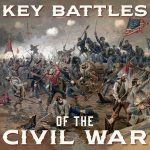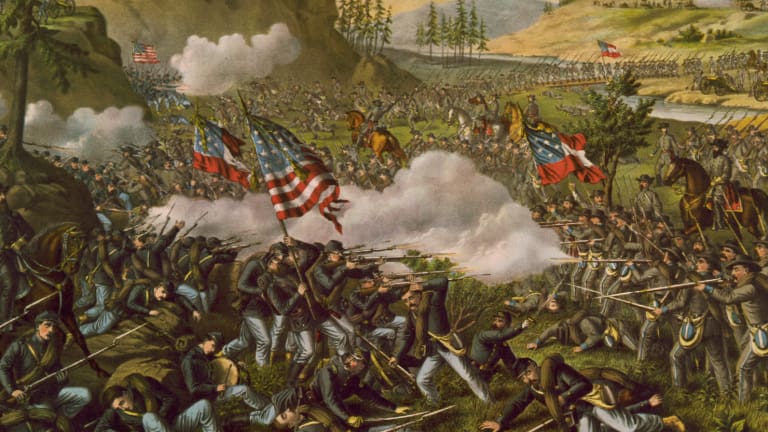The Background- Battle of Chickamauga:
In Battle of Chickamauga , Confederate General Braxton Bragg retreated from Knoxville and Chattanooga, Tennessee, without a fight, with the supposed intent of setting up a masterful counterattack. He was pursued by hard-drinking (he was a Catholic convert), hard-swearing (his brother converted too and became a bishop), Yankee General William S. Rosecrans (“Old Rosey”—a West Pointer who had graduated fifth in his class).
The Battle of Chickamauga:
The armies collided in a deeply forested area near Chickamauga Creek. Visibility and room to maneuver were minimal, and the fighting was fierce with virtually every unit committed to combat. After a bloody but inconclusive opening round, Rosecrans pulled his men back under cover of nightfall, tightened the Union lines, built up log breastworks, and took up defensive positions.
Bragg, meanwhile, planned to flank the Federal left, which, unfortunately for him, was exactly the point that Rosecrans decided to reinforce. Bragg, however, now had another hammer to bludgeon the Federals: James Longstreet had arrived, detached from Lee’s command. Longstreet’s journey from Virginia had been detoured and delayed because of the Federal capture of the railroad at Knoxville. He finally found the battlefield by riding through the dark and asking directions from Federal troops— neither side recognizing the other in the black night.
At daybreak, the attack on the Federal left was pushed hard but went nowhere. The morning’s fighting was another bloody stalemate, until the Federals mistakenly left a gap in the center-right of their line. Confederate General John Bell Hood—riding to battle with one arm in a sling, and suffering a wound that would cost him a leg—led a charge against the Federal right flank. As the Federal right dissolved, Longstreet shifted his own men to the right and charged through the gap, shattering the Union line and driving Rosecrans and the Federal army into flight.
Union Major General George H. Thomas saved the day for the Federals, becoming “The Rock of Chickamauga.” He regrouped the Federals on the high ground at Snodgrass Hill, from which the Confederates couldn’t dislodge them until dusk. Thomas gave ground so stubbornly that the Confederates, exhausted, finally stopped pressing him. Thomas then withdrew his men in good order to Chattanooga.
What You Need to Know:
Battle of Chickamauga was Longstreet’s return to form after Gettysburg. His aggressive performance earned him the nickname, “Old Bull of the Woods.” At Chickamauga the Confederates for once outnumbered the Federals, 65,000 to 62,000 men. They also took the worse casualties: more than 18,000 to more than 16,000. Though a Confederate victory, it was a victory that, because of poor generalship by Braxton Bragg, achieved little, except to reassure the Southern people that all was not lost in Tennessee.
The Battle of Chickamauga marked the end of Union Maj. Gen. William Rosencran’s offensive into southwestern Tennessee and northwestern Georgia and the most significant Union defeat in the Western Theatre. More died here than in any other battle, save Gettysburg. After the battle Union forces retired to Chattanooga while Confederates besieged the city by occupying the surrounding heights.
The Strategic Situation in the East after Gettysburg
- After Meade’s failure to pursue Lee after Gettysburg, Lincoln told him to hold his position. He was to threaten Lee but not attack.
- Davis ordered that two divisions in the Army of Northern VA to reinforce Bragg’s army in north Georgia.
- There will be few minor engagements between Lee’s and Meade’s armies over the next few months, but for the most part, the Virginia front is quiet and takes a “back seat” to the West.
The Strategic Situation in the West after Vicksburg
-
-
-
- Now that the entire Mississippi River was in Union hands, Grant and other Union leaders were not sure what to do next.
- They could focus their efforts in the Trans-Mississippi region (LA, TX, AR), or they could instead concentrate on the Gulf states.
- Grant and Nathaniel Banks wanted to attack Mobile, AL, the last major Confederate port left on the Gulf of Mexico.
- Halleck wanted to focus on the Trans-Mississippi. He thought that TX, LA, and AR could be knocked out of the war.
- Lincoln agreed. He wanted TX’s cotton, and he wanted to make sure France (who had invaded Mexico) would not help the Confederacy. Lincoln also thought that TX, AR, and LA could be quickly brought back into the Union if Federal troops invaded them.
- Lincoln decided that Banks would lead an invasion of Texas while Grant would push Joseph Johnston (now in charge of Confederate forces in the West) eastward out of Jackson and toward Georgia. Grant would also clean rebel forces out of west Mississippi to shore up Federal control of the Mississippi River.
- Grant put Sherman in charge of driving Johnston out of Jackson and tear up Confederate railroads there. He succeeded in this. (Mention “Sherman Neckties”)
-
-
Southeast Tennessee / North Georgia
- The major Union army in this theater was Rosecrans’ Army of the Cumberland, stationed just outside Chattanooga. In the Tullahoma campaign, Rosecrans had driven Bragg out of Tennessee.
- Lincoln wanted Rosecrans to continue driving Bragg southward. He feared that Johnston and Bragg might unite their forces and possibly reconquer part of Tennessee.
- Rosecrans was slow to move. It was late July (1863) before he got into motion.
- Meanwhile, Lincoln had ordered Ambrose Burnside with a small army to take Knoxville, TN. There were many Unionists there, and Lincoln had wanted to liberate them for a long time. Burnside captured the city on September 3.
- Beginning on August 16, Rosecrans gradually maneuvered Bragg out of Chattanooga without a fight. By September 9, Bragg had to abandon Chattanooga. This was a major Union accomplishment, since the city was of great importance.
- Now all of the major cities in Tennessee were in Union control. Bragg had to retreat into Georgia. He had been pushed back more than 80 miles.
- Bragg deployed his army along a meandering creek called Chickamauga (“River of Death”)
- Rosecrans, thinking the Confederate Army of the Tennessee was spent, spread out his army over a long arc. Little did he realize that Bragg (now reinforced with two divisions from Lee’s army) was planning an offensive.
- The Union high command learned about Bragg’s planned attack, but too late to send Rosecrans any reinforcements.
- Bragg hoped to hit the isolated pieces of Rosecrans’ army.
The Battle of Chickamauga
- Bragg planned to move his army around that of Rosecrans and get between the Federals and Chattanooga. They would then drive the Federals into a cul-de-sac and encircle them.
- There was light skirmishing on September 18, but the battle began in earnest on the 19th.
- Nathan Bedford Forrest’s cavalry ran into a Union infantry detachment. Both sides sent reinforcements and the battle spread and escalated. Neither side gained an advantage. The two sides fought for 12 hours, with neither gaining an advantage.
- The ground is extremely dry due to drought, so that the entire battlefield is covered with clouds of dust.
- (One of the Federal divisions was commanded by a general named Jefferson C. Davis).
- General James Longstreet arrived that evening (getting lost on the way to Bragg’s headquarters and not arriving until 11 PM). Bragg gave him command over half the army (the right). He gave Leonidas Polk command over the other half (the left). The plan was to hit the Federals all over the line.
- That evening, the temperature got down near freezing, but both armies were forbidden to light fires so they would not give away their position.
- The next day (Sept. 20), Bragg ordered Polk and Longstreet to attack early in the morning. But they did not begin until several hours later.
- A gap developed in the Union line. Longstreet send troops toward it, and they punched a hole right through the line. Rosecrans’ entire right wing (1/3 of the army) broke and ran. “I saw our lines break and melt away like leaves before the wind.” Rosecrans himself retreated.
- Rosecrans and the Union right wing (1/3 of the Union army) retreated all the way back to the outskirts of Chattanooga. The Federals had 8000 men captured, 15,000 muskets, 51 cannons and many other supplies.
- The Confederates pressed the Union left. General George Thomas rallied the remaining Federals into a strong defensive position (“Horseshoe Ridge”) and kept the Confederates at bay for several hours. He and the army then retreated in good order to Chattanooga. Thomas was given the nickname “The Rock of Chickamauga.”
- The Confederates, sensing their victory, raised a great rebel yell. Bragg wasn’t so sure. A Confederate soldier told him “Yes, General, we have won a great victory. The Federals are in retreat” Bragg replied, “Do you know what a retreat looks like?” The soldier replied “Yes, General, I ought to know. I have been with you for your whole campaign.”
- Rosecrans wired Washington “We have met with a severe disaster.” Lincoln said “Rosecrans was confused and stunned like a duck hit on the head.”
- Battle of Chickamauga was the largest battle in the western theater and the second bloodiest (in terms of total casualties) in the war.
- The Confederates had 18,000 casualties, while the Federals had 16,000. It was the biggest Confederate victory in the west (and the last Confederate victory anywhere), but it brought no strategic reward. Bragg made no effort to push the Federals further back.
 Would you like to learn the complete history of the Civil War? Click here for our podcast series Key Battles of the Civil War
Would you like to learn the complete history of the Civil War? Click here for our podcast series Key Battles of the Civil War
Cite This Article
"Battle of Chickamauga (Sept. 18-20, 1863)" History on the Net© 2000-2024, Salem Media.
April 23, 2024 <https://www.historyonthenet.com/battle-of-chickamauga-september-1863>
More Citation Information.






